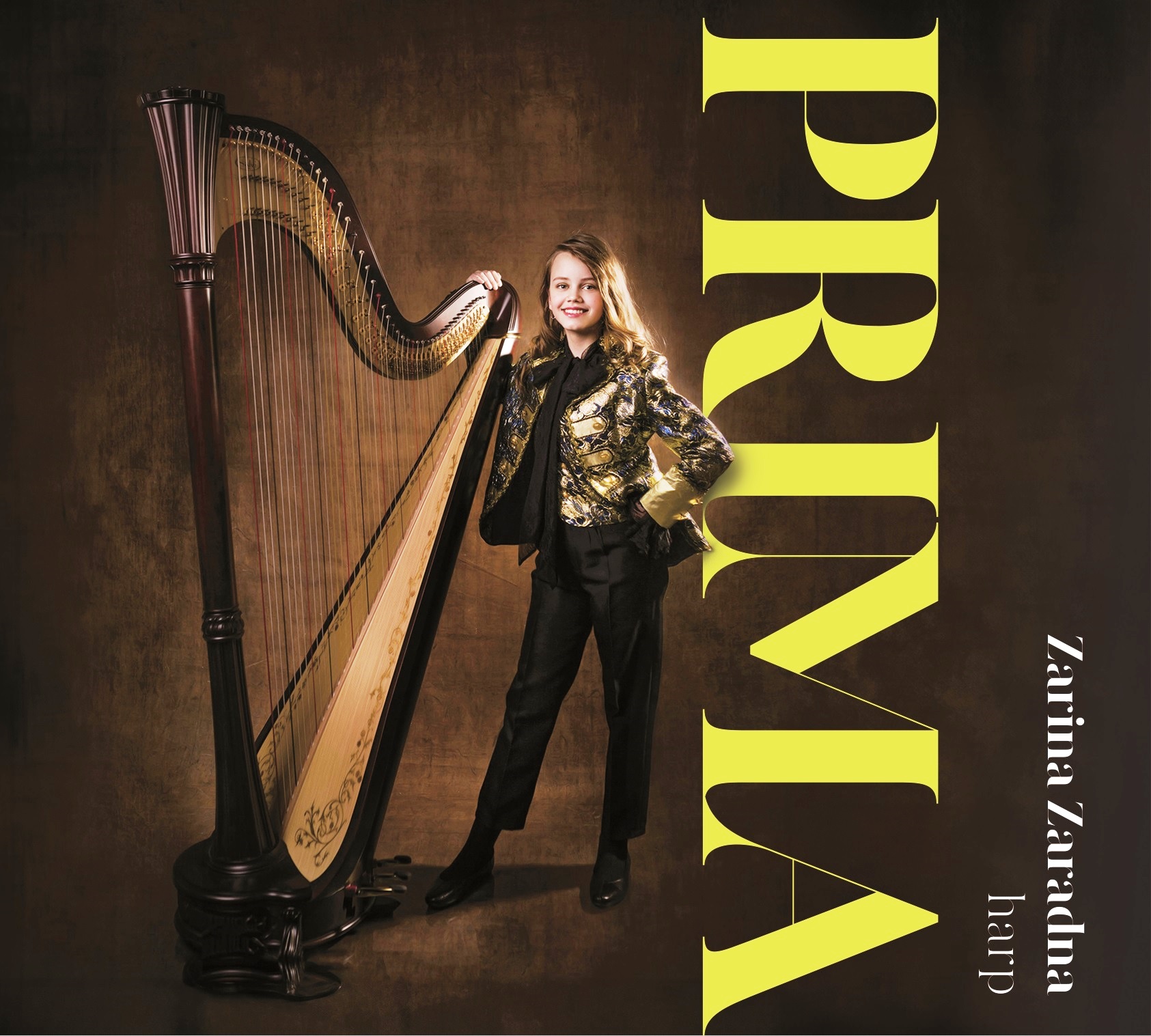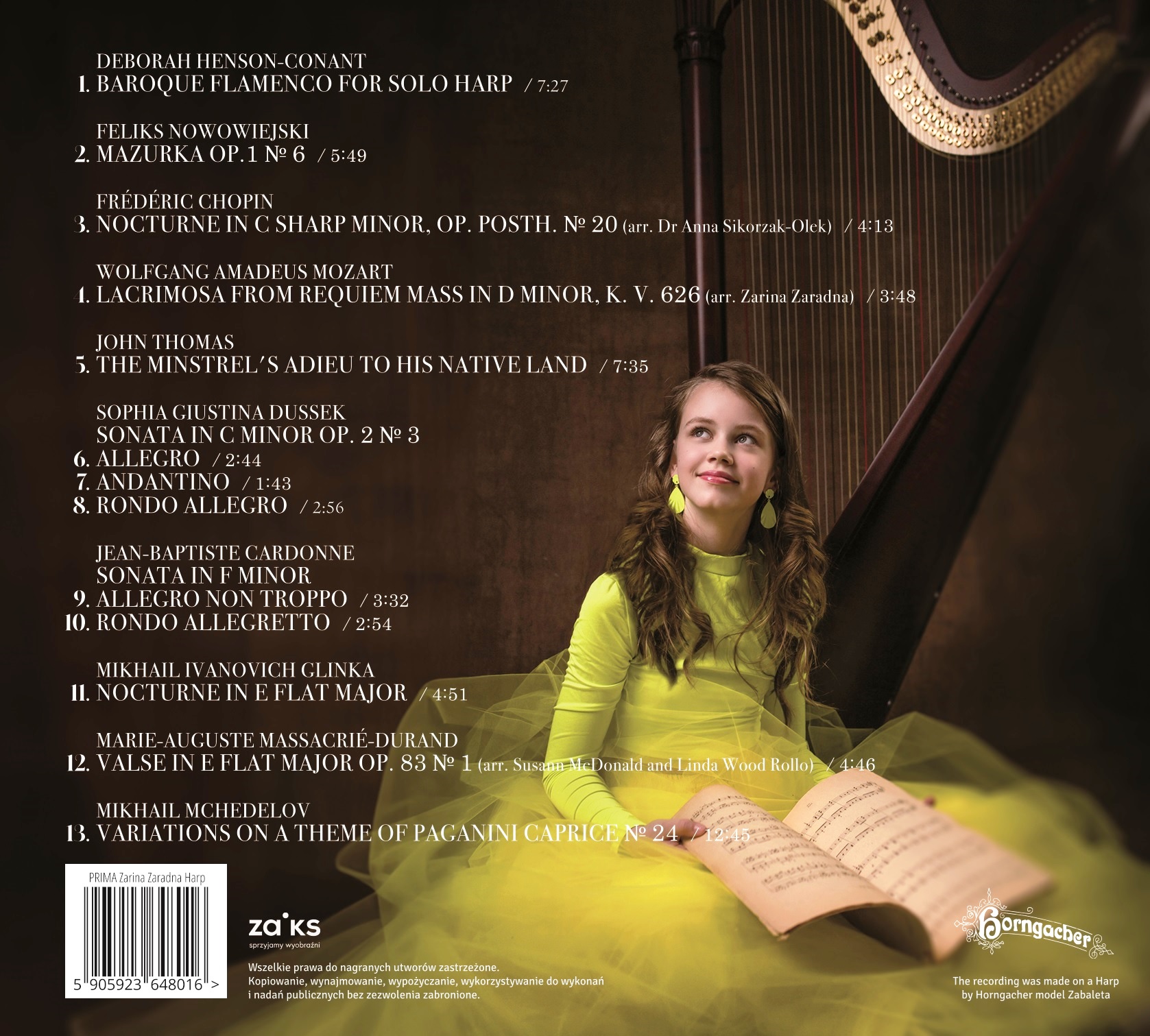Album CD
Zarina Zaradna - HARPIST
PRIMA
Zarina Zaradna harp
Album CD
już w sprzedaży!
The CD album is
now on sale!

Drogi Przyjacielu! Super, że jesteś zainteresowany moim albumem “PRIMA Zarina Zaradna harp”.
Koszt płyty razem z wysyłką w dowolne miejsce w Polsce – 110 zł.
Numer konta do wpłaty: Zarina Zaradna
91 1020 4027 0000 1602 1345 3271
W tytule wpłaty: Wpisz proszę adres na jaki mam wysłać płytę. Jeśli płyta ma być z dedykacją, proszę napisz do mnie maila: zarina.zaradna@gmail.com
Dear Friend!
Great that you are interested in my album. I will be happy to send you the CD anywhere in the world. Write to me at: zarina.zaradna@gmail.com, and I will send you the price of the CD including shipping costs.
See you!

LIST OF PIECES ON THE ALBUM
1. DEBORAH HENSON-CONANT (1953) – Baroque Flamenco for Solo Harp
American harpist and composer. Called the “hip harpist”, she is known for her flamboyant stage presence and innovation in the field of electric harps.
Deborah Henson-Conant describes her music as “cross-genre: jazz-pop-folk-blues-flamenco-celtic”. Deborah performs with one-person shows in theatres, philharmonics and festivals. She also performs with symphony orchestras. Her performances combine music with theatrical and fictional elements. She orchestrates all his own music. It often involves symphonic musicians in unexpected ways. In October 2013, Henson-Conant performed and
represented the United States at the 7th Annual World Harp Festival in Asunción, Paraguay.
2. FELIKS NOWOWIEJSKI (1877-1946) – Mazurka Op. 1 No 6
Polish late Romantic composer, conductor, pedagogue, virtuoso organist, papal chamberlain. He was born in Barczewo near Olsztyn. He studied in Regensburg and Berlin. From 1909 to 1914 he was the artistic director of the Kraków Music Society. In January 1910, he wrote music to Maria Konopnicka’s poem “I won’t leave the land where our family came from”, later known as Rota. On July 15, 1910 in Kraków, on the 500th anniversary of the Battle of Grunwald, at the ceremony of unveiling the Grunwald Monument, the choirs gathered in Matejki Square, conducted by Feliks Nowowiejski, performed “Rota” for the first time in public. The song in this composition became one of the most important Polish songs. hymn songs. In 1914 he went to Poznań, where he organized symphonic and choral concerts, as well as his own organ recitals. After regaining independence, he became permanently attached to the reborn Poland. On November 18, 1919, he settled permanently in Poznań. From 1920, he taught the organ class at the State Conservatory in Poznań, where he also served as a conductor. In the years 1935–1939 he led the City Symphony Orchestra in Poznań. After the outbreak of World War II, he was hiding in Kraków. He returned to Poznań in August 1945. Two dances “Mazurek” and “Krakowiak” from the album “Tańce Polskie” bear opus 1 no. 6 and 7. They were composed during the composer’s studies in Berlin. Found in the Raczyński Library in Poznań and published by A. Sikorzak-Olek in the Polska Muzyka harpowa publishing house.
3. FREDERIC CHOPIN (1810-1849) – Nocturne cis-moll Op. posth. No 20 – Arr. for harp Anna Sikorzak-Olek
Polish composer and pianist. He is considered one of the greatest Romantic composers, as well as one of the most important Polish composers in history. Chopin probably composed the Nocturne in 1830 in Vienna. The work was first published in Poznań in 1875 by the Leitgeber publishing house. The song became very popular in 2002. Polish director – Roman Polanski directed the war drama “The Pianist”. The film is the autobiography of Władysław Szpilman, a Polish pianist and composer of Jewish descent. The action of the film begins at the headquarters of the Polish Radio, which in September 1939 was located at ul. Zielna in Warsaw. Here, Władysław Szpilman was playing Nocturne in C sharp minor on the piano, when suddenly, during his playing, aerial bombs began to fall on Warsaw. The film also ends at the headquarters of Polish Radio. This time, after the war, Władysław Szpilman plays Fryderyk Chopin’s Nocturne in C sharp minor again for radio listeners.
4. WOLFGANG AMADEUS MOZART (1756-1791) – Lacrimosa from Requiem Mass in D minor, K. V. 626 – Arr. for harp by Zarina Zaradna
Lacrimosa means crying. A key excerpt from the Dies Irae, which is part of the requiem mass of the classical Roman rite (Requiem) in the Catholic Church. Mozart accepted the order and received payment, but did not finish the work because death prevented him from doing so. He died at the age of only 35. The work was completed by Franz Xaver Süssmayr, Mozart’s student.
Zarina, deeply moved by the outbreak of war in Ukraine in February 2023, arranged Lacrimosa for harp when she was only 11 years old. In this way, she paid tribute to the people who gave their lives in defense of their homeland.
5. JOHN THOMAS (1826-1913) – The Minstrel’s Adieu to His Native Land
Welsh composer and harpist. He was the eldest of seven children, four of whom also played the harp. John Thomas began by playing the triple harp, which had three sets of strings and was very difficult to play. At the age of 14, he was admitted to the Royal Academy of Music in London. He taught at the Royal College of Music, where he eventually became a professor. He also wrote an opera, a symphony, two harp concertos, and overtures. In 1872 he was appointed harpist to Queen Victoria. The Minstrel’s Adieu to his Native Land is a theme and variations for solo pedal harp, each variation featuring a different harp technique. The repeated note effect in the second variation is reminiscent of the traditional Welsh style of harp playing.
SOPHIA GIUSTINA DUSSEK (1775-1831) – Sonata in C Minor Op. 2 № 3
6. Allegro
7. Andantino
8. Rondo Allegro
Sophia Dussek (maiden name Corri) was a Scottish singer, pianist, harpist and composer of Italian descent. She also played a large role in introducing Mozart’s music to London. In 1792 she married Jan Ladislav Dussek. Sophia left behind a collection of about 70 compositions, including original works, variations (mainly Scottish melodies) and pieces for the harp. In the sonatas one can find the typical features of her music: brilliance and freshness, the originality of many passages and a great sense of proportion that ensures that no theme, even the least original, does not tire the listener.
JEAN-BAPTISTE CARDONNE (1760-1803)- Sonata in F minor
9. Allegro non troppo
10. Rondo Allegretto
Virtuoso harpist and composer. He was the son of the violinist Jean-Guillain Cardon – court violinist in Versailles. In 1784 he wrote the book The Art of Playing the Harp. Cardon greatly developed the technique of playing the instrument, thus contributing to a hitherto unknown virtuosity in the art of playing the harp. Due to the turmoil associated with the French Revolution in 1789, he and many court artists were in danger of death. Jean left France and found a safe haven in Russia, in Saint-Petersburg at the court of Empress Catherine II. Here he became a member of the orchestra, then was promoted to the position of concertmaster. He was also a music teacher. Jean died in Saint-Petersburg. His compositions are marked by Slavic folk culture. Sonata in F minor from the collection “Journal d’ariettes italiennes et autres avec accompagnement de la harpe par J.-B, Cardon” (Saint Petersbourg, 1797)
11. MIKHAIL IVANOVICH GLINKA (1804-1857) – Nocturne in E flat major
He was born in a village near Smolensk. Mikhalia Glinka’s great-grandfather was a Polish nobleman from the Glinka family, Trzaska coat of arms. After the Polish-Lithuanian Commonwealth lost the Smolensk land, Glinka’s family adopted Russian citizenship. The tsarist authorities preserved landed goods and noble privileges for the Smolensk nobility, including old coats of arms. Glinka’s work had a great influence on the greatest Russian composers, such as Pyotr Tchaikovsky, Nikolai Rimsky-Korsakov and many others. Glinka studied and worked in Sankt-Petersburg where he became acquainted with, among others, Adam Mickiewicz. From 1830, he traveled extensively, including to Milan, Vienna, Berlin, Paris. In 1848-1851, Glinka stayed in Warsaw for a longer period of time. Here he was composing songs. Toward the end of his life, Glinka wrote music to Church Slavonic liturgical texts. He died in Berlin in 1857. Glinka wrote few pieces for the harp. The most important of these is the Mozart Variations. The theme is taken from the opera “The Magic Flute” (1822) and the Nocturne in E flat major from 1828. It was created when outstanding harpists appeared in the circle of Glinka’s friends: the brothers Schulz and Nikolay Devitte.
12. MARIE-AUGUSTE MASSACRIE-DURAND (1830-1909) – Valse in E flat major Op. 83 No 1 – Arr. for harp by Susann McDonald and Linda Wood Rollo
He was a French music publisher, organist and composer. He studied at the Paris Conservatory. He started as an organist in 1849. In 1869, he founded the publishing company Durand-Schoenewerk & Cie. The publishing house had rights to early Wagner operas. Durand became an expert in publishing the works of French composers, including composers Claude Debussy, Maurice Ravel and many others. As a publisher, Durand was involved in promoting modern music, supporting musicians – composers. Valse in E-Flat Major Opus 83 was popularized on the harp by notable harpists Susann McDonald and Linda Wood Rollo.
13. MIKHAIL MCHEDELOV (1903-1974) – Variations on a Theme of Paganini Caprice No 24
IReal name Mchedlishvili. Georgian harpist, music teacher, composer. He began his studies at the Tbilisi Conservatory. During the outbreak of World War II, he was called up for military service, but due to his illness he returned to Tbilisi, where he taught at the Conservatory for two years and worked with local orchestras. After the end of the war, he moved to Moscow, where he took the position of head of the string instruments department at the Conservatory. Mchedelov is the composer of many works for the harp, the most famous of which are Variations on a Theme by Paganini and a number of didactic works. Under the editorship of Mchedelov, the book “The School of Playing the Harp” was published twice.
Thanks to everyone who contributed to this album:
PROFESSOR
Dr. Anna Sikorzak-Olek
SOUND DIRECTOR
Zbigniew Kusiak
HARP MANUFACTURER
Horngacher company
RECORDED AT
Polish Radio S.A.
Studio S2
Warsaw Poland
July 2023
MADE IN POLAND
October 2023
